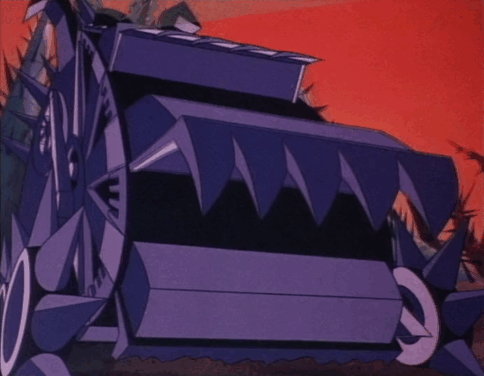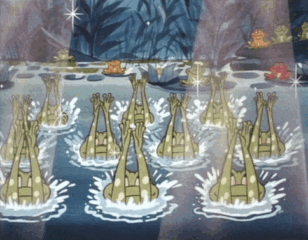originally posted at https://canmom.tumblr.com/post/691052...
Dobra večer, prijatelji! Vrijeme je za Večer animacije.
Good evening, friends! It’s time for Animation Night. Tonight we’re heading over to Croatia, to look at the films directed by Milan Blažeković, namely Čudesna šuma (The Elm-chanted Forest, 1986) and its sequel Čarobnjakov šešir (The Magician’s Hat, 1990).
Why? Well, my dear @mogsk has been working on translating a Ukrainian fansub of the latter film into English, which to our knowledge does not have an extant English sub. So, I don’t want to boast that this film has never been seen with English subtitles because I have no way of verifying that, but at the very least right now you won’t be able to get it anywhere else~

So, who’s this guy, what are his films like? I’ll admit, I was unfamiliar, so let me bring in a scholar who knows a thing or two, Midhat Ajanović Ajan, who writes the following in introduction to his biography of Blažeković:
If it did not sound like a cliche, slightly shabby from overuse, I would have called this article, and the entire book for that matter, A Croatian Disney. There is not a single animated filmmaker in Croatian, or the entire region, who is generally betternsuited than Milan Blažeković to be compared with the giant of animation and film. Blažeković’s life and work are inseparably linked with the famous American, who remains the synonym for the art of the animated image. Blažeković made three animated feature films in the classic cel animation technique, which placed him in the select company that has fewer than a dozen European members and brought him as near as possible to his great idol. He made the films despite the fact that he was creating in an enviroment which had made a global impact by moving away from Disney’s canons and by opposing the domination of his esthetic model.
I can’t find any copy of said biography on libgen, so the actual contents will have to remain a mystery. The way Mogs describes it to me, however, it fits into a broader tradition of frenetic, creative Eastern European animation, similar to such films as the wonderful Bulgarian Treasure Planet we watched back on Animation Night 7. (Sadly, like many early Animation Nights, I did not write this one up in the depth I would have liked. One day I hope to revisit a lot of these earlier issues!) There is less concern with the weighty realistic motion prized by Disney or the realist school in Japan, and more concern with ‘life’ of a different kind: unexpected, weird, surprising motion.

Such animation was the result of an explicit philosophy at the Zagreb School of Animtation, described in this article by Sanja Bahun…
“Life is warmth. Warmth is movement. Movement is life. Animation can be lukewarm or boiling. Cold animation isn‟t animation; it is like a stillborn child. To make animated cartoons means to rub tree trunks against each other until there is a spark perhaps or just a little bit of smoke. Take a kilogram of ideas (if possible not too confused), fifty kilograms of talent, and a few thousands of drawings. Stir it well and then with a bit of luck you won’t get the right answer to your question.” (quoted in Petzke 1996: 53)
For the Zagreb School of Animation, one of the arguably most significant phenomena in both Croatian and Yugoslav cinematography, to animate never meant to imitate reality, but rather to give it a design, or, better still, an “interpretation” (Vukotić 1978: 15).
School here is in the sense of ‘school of thought’, like the ‘realist school’, not a literal building - but the Zagreb School was associated with a studio, Zagreb Film, and a long-running animation festival, Animafest (the second animation festival in Europe after Annecy). In Bahun’s account, its origins come in the 50s, at which point Yugsolavia had but recently split from the Soviet union under Tito, creating the context for an anti-Soviet animated film The Great Rally directed by Fadil Hadžić, the editor of a satirical magazine.

From this was born Duga Film, a short-lived production company which launched the careers of a lot of animators; this gave way to Zagreb Film, the centre of the ‘Zagreb School’. Although very stylistically varied, their films tended to focus on the struggles of a ‘small man’ defying, often unsuccessfully, a larger world; this later gave way to…
a loosely testimonial narrative structure, where the subject‟s interior landscape interacts with the objective world in a string of visually or auditorily commanding phantasmagorias (Dragić‟s Diary [Dnevnik, 1974] and Gašparović‟s Satiemania)
and then by the 80s, a turn to horror. The main thing unifying them all was a commitment to limited animation techniques: loops, reusing cels, and multiplane effects - though, in a sense more like the oldschool Fleischers than TV anime.
But! We’re not really here to talk about the Zagreb school, but what came next. So, The Elm-Chanted Forest: this was the first feature-length Croatian animation, an American collaboration which came at a point when Zagreb Film was in decline, but nevertheless carrying a lot of its spirit. It tells the story of a painter transported into a fantasy world, in which he encounters a series of oddities. Their US collaborators were New York-based Fantasy Forest Films, although I can find out almost nothing about them on a quick search, with databases like imdb listing no credits beyond this one film. Mysteries upon mysteries!

In any case, the work largely seems to be Croatian, although the story was adapted for screen by Fred P. Sharkey. The film was produced by someone called Doro Vlado Hreljanovic, who has a very weird career: grindhouse films in the 70s and early 80s, this one upbeat animated fantasy film, and then made two volumes of the news-footage snuff/shock series Faces of Death in the 90s. A fascinating rabbit hole given I had not even known this series existed, but otherwise unrelated…
So… let’s at last talk about the director, Milan Blažeković! He had previous directed short films such as Largo and episodes of the popular TV series Professor Balthazar.
Here’s an episode of Professor Balthazar narrated in English:
Further short films include The Fish, Ikarus, Vergl and Gorilla Dance (1968) and The Man Who Had To Sing (1971), and animation for Vladimir Petek’s experimental film Zaklon (1967). He also contributed animation to longer projects, such as the Croatian-Canadian animated environmental film Man: The Polluter - I suppose Yugoslavia’s position as a ‘non-aligned’ country made it possible to collaborate with NATO countries like Canada? I would like to expand more on these, but unfortunately it is unclear where to find most of them. Here’s The Man Who Had to Sing, at least, a dark little story about a child who won’t stop singing and gets rejected by just about all of society.
So. Elm-chanted was released in 1986, as far as I can tell simultaneously in Croation in Croatia and English in the US. The Croats loved it, but the Americans largely didn’t get it, which in Bahun’s account is likely because it’s an odd hybrid of the Disney school and the Zagreb school, with very flat staging. Nevertheless, a copy managed to make its way to the house of @mogsk, where it became a cherished childhood memory which would decades later inspire her to go looking for it… and that brings us to the second film, The Magician’s Hat:

Although more elaborate in its animation, this sequel was no longer an international collaboration, and released only in Croatian. Which means it’s almost unknown outside of Croatia, but we can thank the efforts of the Ukrainian fansubber Magmator, founder of RG Gliger (gliger.at.ua), a fansubbing site specialising in pokémon but also other animated films. Thanks to them, a Ukrainian-language .srt file was available which Mogs could machine translate, cleanup, and re-time. (Of course, if a Croatian speaker could help, we could make a better fansub~)
So what’s this one about? It centres on one Thistle the Magician, the redeemed antagonist of the first film, now battling against a certain Car Mrazomor (Emperor Frostbite), leader of the Frost Witches.
Following this film, the Soviet Union would complete its fall, and Yugoslavia would collapse in an extremely bloody war. Blažeković survived, and in 1997, two years after Croatia became an independent country, he would release his third feature, Lapitch, The Little Shoemaker (Čudnovate zgode šegrta Hlapića), adapting a children’s story in a similar model as his previous films. Returning to Bahun, she says…
To an audience made up of children who grew up exposed to gory television footage, curfews, and air raid sirens, and adults exhausted by the seemingly perpetual cycles of violence, Lapitch, The Little Shoemaker was a welcome escape: it soon became the highest-grossing Croatian animated film ever.
It received a much wider international release, and hopefully we’ll get a chance to see it down the line.
That’s about everything I can find out about these two movies… so now, for the first time (maybe) in English, let’s go and enjoy two truly obscure gems of traditional animation from Croatia! And thank you so much again mogs, who did basically all the work for this one, not just creating an entire fansub but also finding the sources to write about it <3
So… Animation Night 116 will be going live now over at picarto.tv/canmom and films will be rolling in about 30 minutes - hope to see you there!
Comments